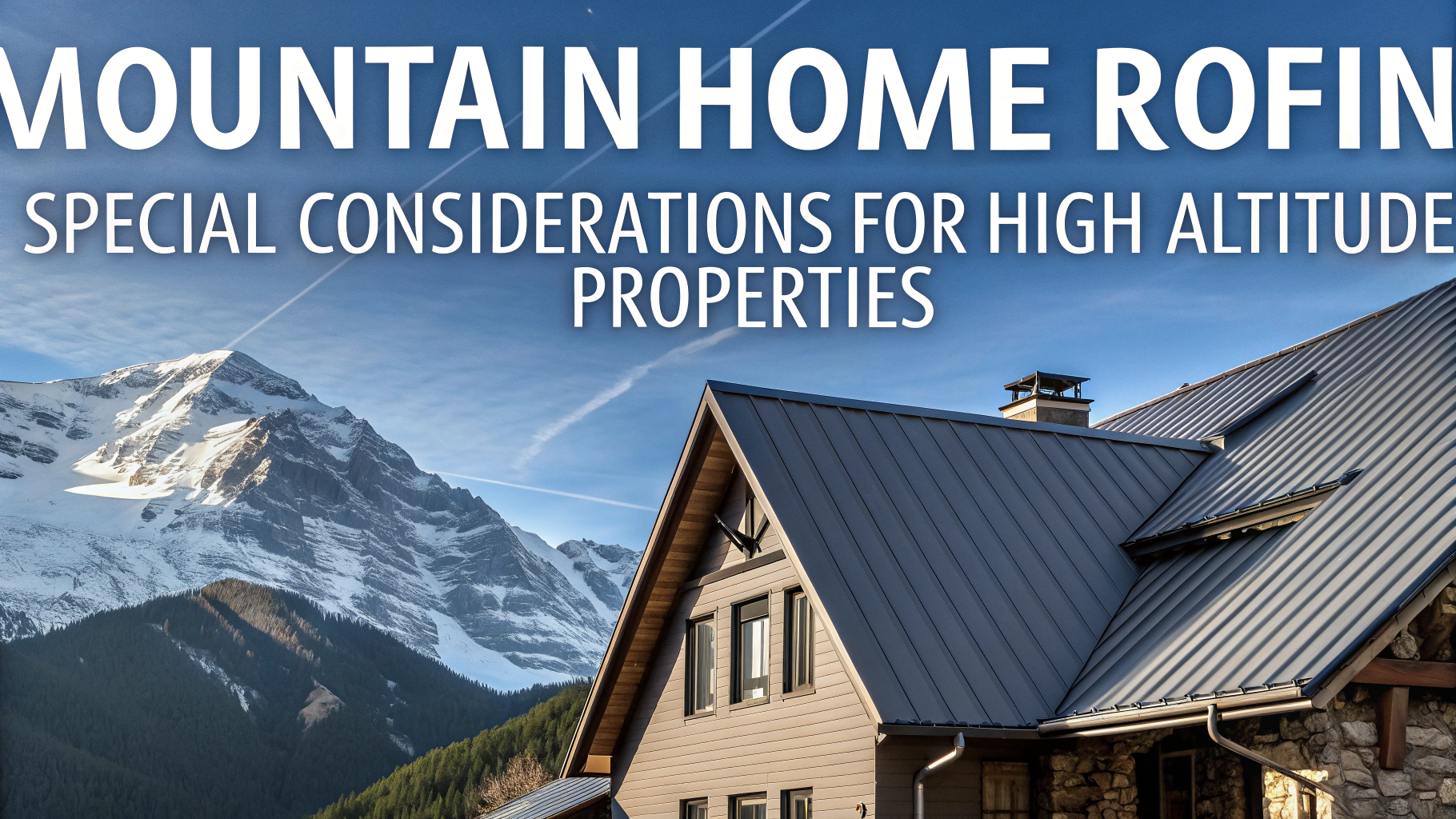Installing and maintaining roofs at high altitudes presents unique challenges that require specialized knowledge and techniques.
Mountain properties face extreme weather conditions, including heavy snow loads, intense UV exposure, and dramatic temperature fluctuations that can significantly impact roofing materials and installation methods.
Understanding these specific requirements helps property owners in mountainous regions make informed decisions about their roofing systems and ensure long-term protection for their homes.
Key Factors Affecting High Altitude Roofing
- Increased UV radiation exposure
- Heavy snow loads and ice dam formation
- Extreme temperature variations
- Strong winds and uplift forces
- Lower air pressure affecting installation
Recommended Roofing Materials for Mountain Homes
Metal roofing stands out as a top choice for high-altitude properties due to its durability and snow-shedding capabilities.
Impact-resistant asphalt shingles with a Class 4 rating offer excellent protection against hail and falling branches.
Synthetic slate provides the aesthetic appeal of natural stone while offering superior weather resistance and lighter weight.
Snow Load Management Solutions
- Install snow guards to prevent dangerous snow slides
- Use heated cables in valleys and along eaves
- Implement proper ventilation systems to prevent ice dam formation
- Design appropriate roof pitch for snow shedding
Special Installation Requirements
High-altitude installations require additional fasteners and specialized techniques to combat stronger wind forces.
Proper underlayment selection becomes critical, with self-adhering ice and water shields recommended for the first 6 feet from the eaves.
Ventilation systems must be carefully designed to account for the reduced air density at higher elevations.
Maintenance Tips for Mountain Properties
- Inspect roof twice yearly (spring and fall)
- Clear snow accumulation regularly during winter
- Check and clean gutters before winter season
- Monitor for signs of UV damage or material degradation
- Address repairs promptly to prevent moisture infiltration
Professional Selection Guidelines
Select contractors with specific experience in high-altitude roofing installations.
Verify that your chosen contractor carries proper insurance for working at elevation.
Request references from previous mountain property projects.
Planning Your Mountain Home Roof Project
Schedule installations during appropriate weather windows, typically late spring through early fall.
Budget for higher material and labor costs associated with mountain installations.
Contact local building departments for specific high-altitude building codes and requirements.
Building a Weather-Ready Roof System
Success in mountain home roofing depends on choosing the right materials, proper installation techniques, and regular maintenance.
For professional assistance with your high-altitude roofing project, contact licensed contractors who specialize in mountain property installations.
Local building authorities can provide additional guidance on regional requirements and recommended practices for your specific elevation.
Environmental Impact Considerations
Energy-efficient roofing materials can significantly reduce heating and cooling costs at high altitudes.
Consider recyclable materials like metal roofing to minimize environmental impact when replacement is needed.
Look for locally sourced materials when possible to reduce transportation costs and carbon footprint.
Advanced Weather Protection Features
- Enhanced flashing systems for vulnerable areas
- Water-tight sealing around roof penetrations
- High-performance ridge vents designed for extreme conditions
- Additional waterproofing layers in critical zones
Cost Management Strategies
Plan for long-term value rather than initial cost savings when selecting materials.
Consider maintenance costs and material longevity in your budget calculations.
Invest in preventive measures to avoid costly repairs due to weather damage.
Investment Protection Measures
- Extended warranties for high-altitude installations
- Regular professional inspections
- Documentation of maintenance for insurance purposes
Securing Your Mountain Home’s Future
A well-designed and properly installed high-altitude roof system provides essential protection for your mountain property investment.
Regular maintenance and prompt attention to repairs ensure optimal performance throughout the roof’s lifespan.
Working with experienced professionals and following local building codes creates a resilient roofing system capable of withstanding mountain climate challenges for years to come.
FAQs
- What unique challenges do high-altitude roofs face compared to those at lower elevations?
High-altitude roofs face increased UV exposure, extreme temperature fluctuations, heavy snow loads, stronger winds, and thinner air that affects material performance and installation. - What roofing materials are best suited for mountain homes?
Metal roofing, slate, concrete tiles, and high-grade asphalt shingles rated for high-altitude conditions are most suitable due to their durability and resistance to UV damage and extreme weather. - How does snow load affect mountain home roofing design?
Snow load requires stronger structural support, steeper pitch angles (typically 6/12 or greater), and proper insulation and ventilation to prevent ice dam formation. - Why is proper ventilation especially important for high-altitude roofs?
Proper ventilation helps manage extreme temperature differences between indoor and outdoor air, prevents moisture buildup, and reduces ice dam formation in winter months. - How often should high-altitude roofs be inspected?
High-altitude roofs should be inspected twice yearly – in spring after snow melt and in fall before winter weather – plus after any major storms. - What role does UV protection play in mountain home roofing?
UV protection is crucial as radiation exposure is 5-10% more intense per 1,000 feet of elevation, requiring materials with enhanced UV resistance to prevent premature deterioration. - How do wind patterns affect mountain home roof design?
Mountain homes experience stronger and more turbulent winds, requiring enhanced fastening systems, wind-rated materials, and proper edge and corner reinforcement. - What special considerations are needed for roof installation at high altitudes?
Installation requires adjustments for thinner air affecting adhesive curing times, specialized equipment for steep pitches, and consideration of seasonal weather windows for completion. - Why do mountain homes often need special ice and water shields?
Ice and water shields are essential to protect against ice dam formation and water infiltration, particularly in valleys and eaves where snow and ice tend to accumulate. - How does altitude affect roofing material choices?
Higher altitudes require materials that can withstand increased UV exposure, extreme temperature changes, and heavy snow loads while maintaining flexibility and durability.
